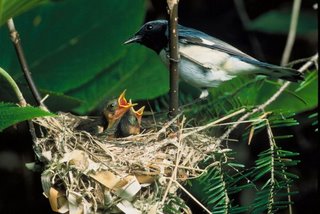Birds of the Mid-Atlantic #25: Black-throated Blue Warbler
As I noted in my post on Saturday, I never get tired of watching black-throated blue warblers. They are a bit easier to watch than other warblers. Black-throated blues tend to stay in middle-level foliage: the tops of bushes and small trees like dogwoods and devil's walking stick. They keep their colorful spring plumage throughout the year, even when other warblers are at their most confusing. They are not shy and will go about their business even with a human watching at close range. Some guides refer to this quality as "confiding."
As you might expect, a male black-throated blue warbler has dark blue upperparts and a black face and throat, with white undersides. Females have greenish-blue upperparts with light-colored underparts. Both sexes show a white patch on the wing at the base of the primaries. Immatures might not show this patch, but otherwise it is a good indicator for the species. In spring, the black-throated blue song is a rising buzz, sometimes transcribed as beer beer beer beeee.
Relatively few black-throated blue warblers breed in the DC area, and those that do nest well to the west, among the ridges of the Appalachians. We only get to see them during two brief periods of the year: spring and fall migration. Luckily, their fall migration is sometimes quite protracted. In DC, they may be seen from mid-August through mid-November. Last year, my last sighting was on November 6; the Maryland Yellowbook gives November 16 as the late migration date. Even though most warblers are already gone, there still may be a chance to see a few black-throated blues before the winter.
As you might expect, a male black-throated blue warbler has dark blue upperparts and a black face and throat, with white undersides. Females have greenish-blue upperparts with light-colored underparts. Both sexes show a white patch on the wing at the base of the primaries. Immatures might not show this patch, but otherwise it is a good indicator for the species. In spring, the black-throated blue song is a rising buzz, sometimes transcribed as beer beer beer beeee.
Relatively few black-throated blue warblers breed in the DC area, and those that do nest well to the west, among the ridges of the Appalachians. We only get to see them during two brief periods of the year: spring and fall migration. Luckily, their fall migration is sometimes quite protracted. In DC, they may be seen from mid-August through mid-November. Last year, my last sighting was on November 6; the Maryland Yellowbook gives November 16 as the late migration date. Even though most warblers are already gone, there still may be a chance to see a few black-throated blues before the winter.
Labels: Birds of the Mid-Atlantic


0 Comments:
Post a Comment
<< Home